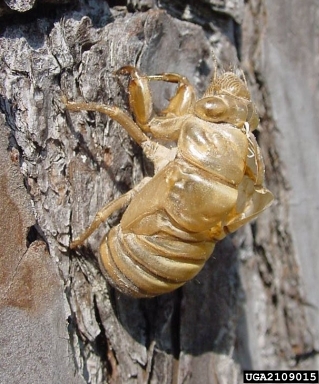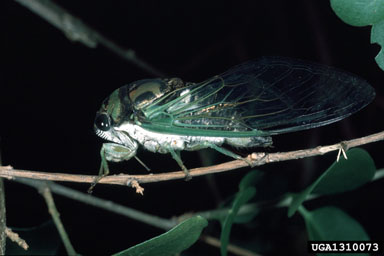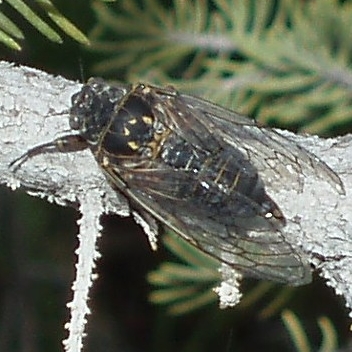Michigan insects in the garden – Season 2 Week 1: Annual cicadas
The cicadas you don’t need to wait 17 years to see and hear emerge every year in Michigan.

Cicadas are a topic of hot discussion due to the recent emergence of the 17-year periodical cicadas (genus Magicicada), whose Brood X overlaps with the far southern portion of Michigan’s Lower Peninsula. The excitement about this emergence overshadows the cicada species who appear annually in nearly all Michigan counties. Approximately 170 cicada species occur in North America, with about 10 species found in Michigan. Though cicadas can be seen and heard every year, a cicada’s life span requires two to five years. These insects, called annual cicadas, do not emerge in synchrony like periodical cicadas, which is why we hear cicadas every year.
Life cycle of a cicada
Cicadas are in the same insect Order as aphids and leafhoppers, have short antennae and use a small sucking mouthpart to feed on plant xylem as adults. Adults lay eggs into slits on twigs or branches (Photo 1). Shortly after hatching, the nymphs fall to the ground and spend the next few years of life underground sipping on nutrients from plant roots. After accumulation of sufficient warmth in the summer, the nymphs emerge to the soil surface, molt their exoskeleton and become an adult.
Often, the nymphs’ molted exoskeleton, sometimes called an exuvia (Photo 2), is confused for an adult, especially when they are attached to plants or trees. This exuvia is a byproduct of having an exoskeleton and is harmless. The adults live up to six weeks before laying eggs and restarting their life cycle.

The dog-day cicada (Neotibicen canicularis), named for the dog-days of summer, is one of the most common cicada species (Photo 3). With black and green markings on its body, this cicada spends much of the day making loud sounds while perched on trees or shrubs. This species is often found on oaks, elm and pine, although it can be found on other trees and shrubs.

Another common group of cicadas in Michigan belong to the genus Okanagana. These cicadas have black and yellow or orange markings on their body (Photo 4).

Why do cicadas make so much noise?
The sound of cicadas is a classic feature of a warm Michigan summer day. Cicadas do not actually make noise from their mouths. Rather, the noise results from or rubbing their wings together or through special muscles beneath their abdomens. Male cicadas make noise to court mates and to use as a warning if a predator threatens them. Cicada sounds are loud and sometimes make conversations difficult, as their sounds can reach 95 – 120 decibels. Cicadas can only make noise consistently when temperatures are above 72 degrees Fahrenheit, and their sounds vary between species.
Do cicadas need to be controlled?
It is rarely worth taking any action to manage annual cicadas. They appear in far lower numbers compared to the periodical cicadas. One of the best tools to reduce cicada populations is the naturally occurring cicada killer wasp, which attacks cicadas and brings them to underground nests. Keeping the cicadas and their songs as a feature of a Michigan summer outweighs the minimal damage they may cause through egglaying scars or limited feeding on roots.



 Print
Print Email
Email





